

“Chromatopia, at first, aims to be a collective project designed by eight individuals, a collective enterprise that negotiates its individual differences within a regime of agreement. The utopic overtones (or undertones?) openly engage the premise of a new and different world, yet the world depicted here is made up of the existing impulses of Shanghai. More towers, more programs, more color — to offer at a political level more publicness too, which may be more atopic in its mission, that is, to make a borderless utopia, one that would infect the life and spirit of the city.” — Neil Denari

↑ Chroma_topia: Generally Different Towers For Shangai installation at RUMBLE, 1025
Two defining images of Chinese modernity have been circulating the media circuit for the past thirty years: 1) the image of a seemingly endless stretch of vertical density on the form of high rise towers, captured in elevation as the stacking of balconies and floor plates, pixelated with air conditioning units, drying laundry and domestic ephemera 2) the image of European towns, copied by the Chinese, inhabited by the middle class, and colonized with the unexpected and often incongruous mannerisms of two cultures forced to intermingle.
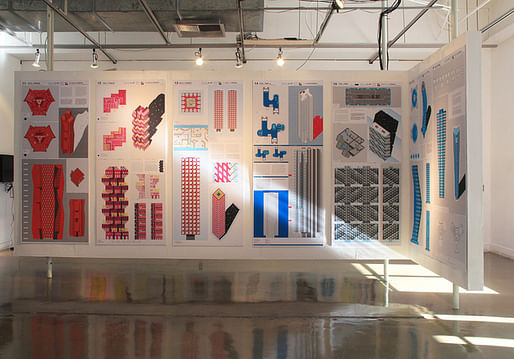
↑ Chroma_topia: Generally Different Towers For Shangai installation at RUMBLE, 1025
The recent history of Chinese modernity is a history of images, and primarily images of architecture. One is the repetitive production of towers and floor plates across a vast landscape of indifference; the other is the doubling of towns and cities according to a unfamiliar categories of originality and authenticity. These two images declare the state of emergency that is the rapid urbanization of China. In both cases, Chinese cities are the sites of serial reproduction, and in all cases architecture plays a central role in the conversation.
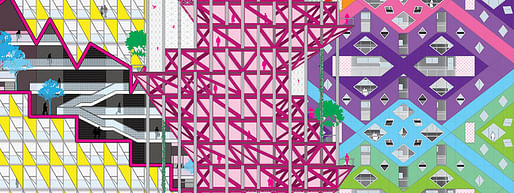
↑ Chroma_topia: Generally Different Towers For Shangai, UCLA Architecture and Urban Design, 2015.
The 2014-15 Research Studio Chromatopia, led by Neil Denari (Professor), with Jia Gu (PhD Student and Teaching Assistant), explores these multiple manifestations of the Chinese city: how does one design around notions of seriality and individuality within a landscape of (post) modernity?

↑ Chroma_topia: Generally Different Towers For Shangai, UCLA Architecture and Urban Design, 2015.
The studio was composed of eight third-year Master of Architecture I students, and organized around a constellation of seminars, lectures, travel research and studio work. The speculative design projects produced in the studio (presented in subsequent book and exhibition in Shanghai) asks questions about the state of the high rise, particularly as it concerns a city like Shanghai, which has more than 1400 buildings over 100 meters tall. How does one design the singular building against this backdrop of collectivity, repetition and rapid urbanization? The studio included a one-week travel component in March, funded by a grant from the Urban Humanities Initiative and the Mellon Foundation, where students investigated in person the very promiscuity which defines Shanghai’s contemporary urban landscape — the realities of unprecedented growth against the backdrop of economy forces, the ebb and flows of money, idea, politics and design.
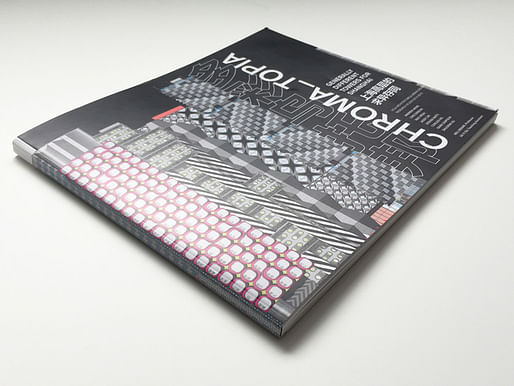
↑ Cover, Chroma_topia: Generally Different Towers For Shangai, UCLA Architecture and Urban Design, 2015.
In an initial two week burst, a site plan was developed by the group consisting of a four level plaza / subterranean world of shopping, cultural consumption and production, parking, and water retention. This thick urban substrate is the plate on which a master plan for 24 towers was designed, each strategically located within a grid system that, to the naked eye, looks inconsistent and erratic. Over the next several weeks, each student designed three towers that, in their interest to be both different and sustainable, focused on oddly enough, the concept of the medium: medium height (80-120 meters), medium form (between the straightforward and the exotic), and medium immersion (color and signs).

↑ Chroma_topia: Generally Different Towers For Shangai, UCLA Architecture and Urban Design, 2015.
Thought of as interchangeable elements, these projects seek out the space between the banal repetition of typical Shanghai tower blocks and the special forms and colors of the super-tall towers that make up the Pudong Skyline. Special attention has been paid to the overall chromatic impact of the catalogue of towers and the environment in which they are placed. Here, every elevation, and in fact most plans, reveal and depict not a diagrammatic coloration, but a real condition of graphic material (viz. painted metal panel façade systems). In the search for a new type of “diagrammatic realism”, we propose buildings that communicate urgency and seriousness even as they entertain or exist in Medium Space.
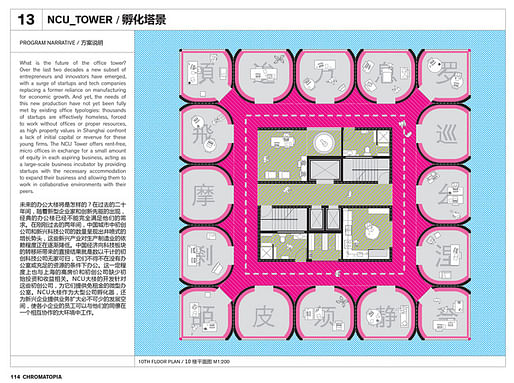
↑ Chroma_topia: Generally Different Towers For Shangai, UCLA Architecture and Urban Design, 2015.
The studio work culminated in a three-month long exhibition in Shanghai in the 2015 biennale Shanghai Urban Space Art Season (Sept. 30 - Dec. 15, 2015) and the publication of Chromatopia, a 200 page exhibition catalogue featuring the work of the studio. The publication also includes essays by Neil Denari and Jia Gu, photographs by Neil Denari and Tim Franco, along with a tower atlas of over 30 tower case studies.
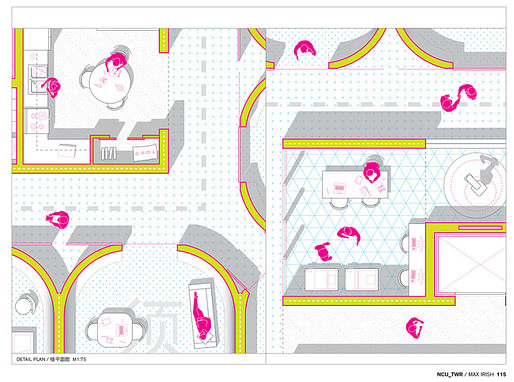
↑ Chroma_topia: Generally Different Towers For Shangai, UCLA Architecture and Urban Design, 2015.
//////
The UCLA’s Research Studio is the capstone studio for third-year Master of Architecture students. The research studio stretches over a year and trains students to engage critically and discursively with contemporary topics in architecture, through their own research and design work, alongside a set of constraints developed around the research topic. Past research studios have been led by highly distinguished faculty, including Thom Mayne, Greg Lynn, Heather Roberge and Roger Sherman, amongst others. Topics include research into robotic environments and integration, disaster and cultural resiliency in Haiti, a graphical masterplan for Westwood, and an investigation into the material behavior of sheet logic in architecture.
No Comments
Block this user
Are you sure you want to block this user and hide all related comments throughout the site?
Archinect
This is your first comment on Archinect. Your comment will be visible once approved.